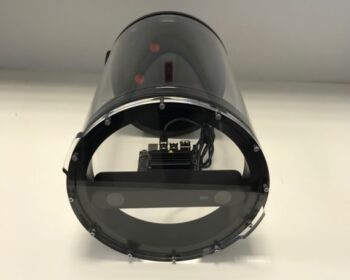The project will produce a Multi-functional management system incorporating two main sub-systems (see sub-figures):
1. Feeding and biomass monitoring
1.1 Feed loss estimation
The control of feeding is achieved using a submerged and remotely controlled IP camera, located at the bottom of the cage, controlled by a microcomputer. The optical system monitors the feeding procedure in real-time mode and send an alarm signal to the end-user upon feedloss detection. The algorithmic scheme for assessing feed pellets loss is based on fusing image processing and computer-vision approaches.
If you want to test the application, contact us and we shall provide you with further details.

Demo Video of the Application
1.2 Biomass estimation using optical systems
The biomass estimation is achieved by applying a combination of technologies. A small but powerful computer manages the frame synchronization and acquisition from the stereo camera (mounted in a submersible housing) (Figure 1), as well as the data (images) transferring to the main system. The intermediate connection between the stereo camera and the main system is also achieved by the computer. Initially, the computer synchronizes the acquired images, keeping them in its local storage. Afterwards, the data are being transferred to the main system. A methodology is developed (using computer vision and Artificial Intelligence algorithms) for the detection of the fish in the acquired images and their mean length (head to tail/posterior end) estimation. (Figure 2).


A specific app is developed and available for potential users ( manual of my My App)
1.3 Biomass estimation using echosounders
Fish density and biomass estimation using scientific echosounders is a standard practice in small-pelagic fish surveys. However, when this technology is applied in the aquaculture setting multiple difficulties come into effect. Physical platform stability issues, scarce studies on the acoustical properties of the Mediterranean species that are of interest in aquaculture, and deviations from linearity due to the high fish densities are all important challenges that hinder the applicability of fisheries acoustic methods in aquaculture.
Integrating concurrent data from optical systems and biological sampling, the project uses split-beam echosounders in order to develop methodological protocols for the quantitative assessment of fish biomass in aquaculture cages.
Deliverables
| Feed loss system | Average weight estimation | Acoustic biomass estimation | ||
| D1.1.1 End-user requirements and technical specifications of the sub-systems | ||||
| D1.2.1 Content and specifications of the databases and experimental data reference tables | ||||
| D2.1.1 Feed loss estimation system in sea cages (hardware and software) | D2.2.1 Automatic average fish weight estimation system (hardware and software) | D2.3.1 Biomass estimation system using echosounders | ||
| D2.1.2 Operation manual for the feed loss estimation system | D2.2.2 Operation manual for the system of automatic average fish weight estimation | D2.3.2 Operation manual of the biomass estimation system | ||
| D4.1.1 Trial and system evaluation results | ||||
| D4.1.2 Technical, financial and utilization study of the systems | ||||
| D4.2.1 Report on the results’ dissemination actions | ||||








